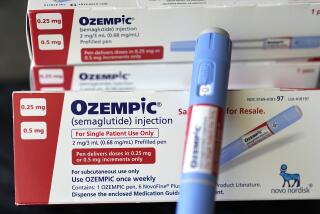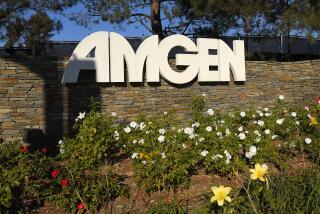Promising Drug Enhances Tiny Amgen’s Reputation
Inside a room the size of a small wine cellar in Thousand Oaks, there’s a constant, eerie squeaking noise as bottles filled with a cherry-red liquid are mechanically rotated on racks in 98.6-degree temperature. Erythropoietin (EPO) is incubating.
It’s not easy to get in that room. Workers must use special magnetic key cards to enter the building, and double doors keep outside air from seeping in.
This is very valuable stuff. EPO figures to be Amgen’s first biotechnology drug and in its dried state, analysts say, EPO will be worth about $100 million a pound.
So far in clinical human tests, EPO has won eye-popping reviews, including one published in the New England Journal of Medicine in January. EPO seems to alleviate chronic anemia in patients with severe kidney disease, who cannot produce enough red blood cells on their own. They need frequent blood transfusions, which carries the risk, however small, of hepatitis or AIDS. Kidney patients given EPO transfusions three times a week after dialysis didn’t need blood transfusions, and patients recovered much of their old energy.
Amgen hopes to get Food and Drug Administration approval for EPO by 1989.
The Thousand Oaks-based company’s scientists played detective to find the molecule containing EPO, then broke apart the DNA blueprint, spliced together genes and cloned the hormone, which occurs naturally in the body and helps produce red blood cells.
“We’re in true designer genes,” said Philip Whitcome, Amgen’s director of strategic planning.
EPO also looks like a wonder drug to the stock market. Amgen’s stock, which closed in over-the-counter trading Monday at $37.625, compared to $12.50 last year, sells for a spectacular 400 times its earnings per share. The average stock on the Standard & Poor’s 500 list sells for 15 times its earnings per share.
In effect, the stock market seems to be pricing the stock in anticipation of the $50 million in annual profits that analysts expect the company to earn five years from now.
“It’s a little scary. People don’t want to miss the boat, and they bet their chips a lot earlier today,” said George B. Rathmann, 59, a big, bearded man who is Amgen’s chairman and chief executive.
Can Amgen ever justify its dizzying stock price with real profits? The answer, increasingly, looks like yes.
“I really do not see any major dangers now,” said Jim McCamant, editor of Medical Technology Stock Letter. “EPO is the kind of dream product every biotechnology firm dreams they have. EPO will pay the bills and certainly allow Amgen to grow and develop other drugs,” said James Fenno, a former vice president of Amgen and now an executive with a Santa Monica biotech firm, Ingene.
Amgen’s stock price is both swollen and volatile, which makes it a prime target for short-selling.
Last month, for instance, Amgen was set to sell another 2 million shares of stock. But in the two days before the offering, many investors took short positions in Amgen--that is, they borrowed Amgen stock, then sold it with a commitment to replace the stock in the near future. They were gambling the price of the stock would go down enough so they could replace it at a lower price and thus turn a profit.
It worked. The short-sellers beat down Amgen’s stock price from $38 to $34. Amgen went ahead with the offering anyway because major institutional investors had been waiting to get their hands on the stock, but the short-sellers picked up $8 million in easy profits.
Amgen’s current market capitalization--the total value of all its stock--places it third among all biotech firms, behind Genentech and Cetus. More surprising is that the current $624-million market value of all Amgen shares now ranks about 750th among all U.S. firms, ahead of many bigger or better-known companies, including Glendale Federal Savings, Nike and Mack Trucks.
Nevertheless, Amgen remains a pipsqueak. For its fiscal year ended March 31, it is expected to report a profit of about $1 million on $30 million in sales, but those numbers don’t mean very much. Only about $1 million of its revenue came from actual sales of products to research labs and universities. The rest are cash advances by Amgen’s research partners, plus interest.
The pressure to produce big is nothing new to Rathmann, a former vice president of research and development for Abbott Laboratories in Chicago. In 1981, when the company was no bigger than an idea, he persuaded venture capitalists to invest $19 million in Amgen. They told him they expected to multiply their investment by 10 times within seven years.
“And suddenly, (even though) you’re still an embryo, you must become a Fortune 500 company. Instead of dreaming about how big and exciting it might be, it is absolute that we must do that or we are a failure,” Rathmann said. (One analgesic for Rathmann’s headaches is that his 3% of Amgen’s stock is now worth about $20 million.)
But Rathmann believes that the company can hit the $50-million profit plateau within five years, mainly because of EPO.
EPO is one of the few biotech drugs in which one company seems to have a clear edge, with plenty to gain if it wins the race to market.
The prize will be orphan-drug status, bestowed by the FDA, granting an exclusive seven-year monopoly to sell EPO to kidney patients in the United States. The FDA offers orphan-drug status as a carrot to encourage research on diseases that have relatively few patients, fewer than 200,000 nationwide.
Amgen plans to finish its U.S. clinical tests soon on EPO and apply for FDA approval by the end of this year. The FDA’s review might last 18 months.
Amgen’s closest competitor in the EPO race is Genetics Institute, a Cambridge, Mass., biotech firm that has linked up with Japan’s Chugai Pharmaceuticals and has started EPO clinical tests overseas.
“Amgen has a substantial lead, I believe it’s a year and a half, over anybody else,” said Denise Gilbert, biotech analyst for Montgomery Securities.
So, with the current rosy picture, what could go wrong?
One unknown is whether Amgen’s patents will be judged as ironclad, thus keeping out some competition. Also, Amgen thus far has been an idea factory, not a manufacturer and marketer of real products. But Amgen is building a $15-million plant in Thousand Oaks to manufacture EPO, and Rathmann suggests that selling EPO won’t be hard to sell.
For anemic kidney patients, he said, the choice between another blood transfusion or an EPO infusion “does not exactly take a sophisticated marketing story.”
What does worry Rathmann is keeping together the fragile makeup of Amgen, especially its 75 research scientists. Amgen, he said, is one of those companies where all the assets go home at night “in tennis shoes.”
Thus far, only a couple of research scientists have left the company. The labs are peopled with young researchers, dressed in white smocks, who play their part in helping a company grow at the edge of a scientific frontier.
Everybody at the company, including secretaries, receives stock options. A half dozen scientists now are millionaires on paper, since the earliest stock options were given at 65 cents a share. But there aren’t Ferraris in the parking lot just yet. Most of the employees aren’t selling.
Rathmann wants Amgen to be more than a one-drug company, so five other biotech drugs are now in human clinical tests, including Granulocyte Colony-Stimulating Factor (G-CSF).
“We will get more profits eventually with G-CSF over six or seven years” than from EPO, Rathmann said.
G-CSF produces white blood cells and so may strengthen the immune system of cancer patients undergoing chemotherapy. Amgen began human clinical trials in November, 1986, on cancer patients at Memorial Sloan-Kettering Cancer Center in New York.
But unlike the EPO race, there are similar white blood cell biotech drugs being tested. “Once you’ve indicated that the molecule exists, it’s the four-minute-mile story,” Rathmann said. What seemed impossible before is suddenly possible, and the competition rushes in.
There are about a dozen biotech companies in the white blood cell race, including Genetics Institute. With a Swiss partner, Sandoz, it began testing GM-CSF in August on patients with cancer, patients getting bone marrow transplants and even AIDS patients to try to slow down the rate of infection.
With few exceptions, the potential markets are much too large to qualify for orphan-drug status. So analysts scratch their heads, tap their calculators and talk of perhaps a $200-million market in the United States for such a drug by the early 1990s, and maybe $1 billion worldwide. For Amgen, Medical Technology Newsletter editor McCamant said, “G-CSF will pay off; the question is how much.”
More to Read
Inside the business of entertainment
The Wide Shot brings you news, analysis and insights on everything from streaming wars to production — and what it all means for the future.
You may occasionally receive promotional content from the Los Angeles Times.











